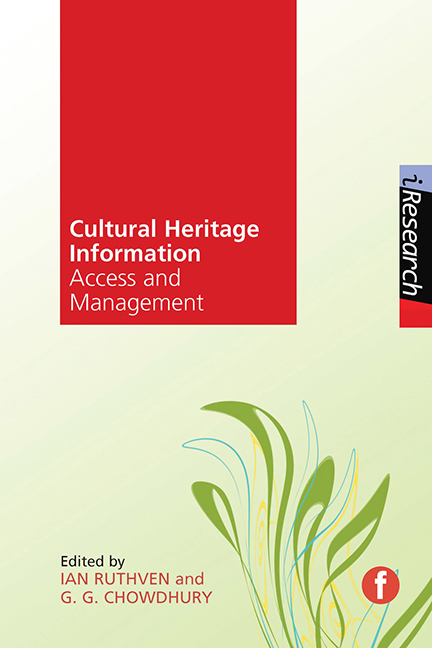Book contents
- Frontmatter
- Contents
- List of figures and tables
- Contributors
- Preface
- 1 Managing digital cultural heritage information
- 2 Digital humanities and digital cultural heritage (alt-history and future directions)
- 3 Management of cultural heritage information: policies and practices
- 4 Cultural heritage information: artefacts and digitization technologies
- 5 Metadata in cultural contexts – from manga to digital archives in a linked open data environment
- 6 Managing cultural heritage: information systems architecture
- 7 Cultural heritage information: users and usability
- 8 A framework for classifying and comparing interactions in culturalheritage information systems
- 9 Semantic access and exploration in cultural heritage digital libraries
- 10 Supporting exploration and use of digital cultural heritage materials: the PATHS perspective
- 11 Cultural heritage information services: sustainability issues
- Index
10 - Supporting exploration and use of digital cultural heritage materials: the PATHS perspective
Published online by Cambridge University Press: 10 September 2022
- Frontmatter
- Contents
- List of figures and tables
- Contributors
- Preface
- 1 Managing digital cultural heritage information
- 2 Digital humanities and digital cultural heritage (alt-history and future directions)
- 3 Management of cultural heritage information: policies and practices
- 4 Cultural heritage information: artefacts and digitization technologies
- 5 Metadata in cultural contexts – from manga to digital archives in a linked open data environment
- 6 Managing cultural heritage: information systems architecture
- 7 Cultural heritage information: users and usability
- 8 A framework for classifying and comparing interactions in culturalheritage information systems
- 9 Semantic access and exploration in cultural heritage digital libraries
- 10 Supporting exploration and use of digital cultural heritage materials: the PATHS perspective
- 11 Cultural heritage information services: sustainability issues
- Index
Summary
Introduction
Cultural heritage involves rich and highly heterogeneous collections that are challenging to archive and convey to the general public.
Hardman et al., 2009, 23This statement describes two aspects that make access to cultural heritage information challenging: the heterogeneous nature of many cultural heritage collections and the growing need to provide non-specialist users with access to cultural heritage content. Cultural heritage institutions (libraries, museums and archives) hold an enormous and rich variety of digital content covering a broad range of subjects, such as natural history, ethnography, archaeology, historic monuments and fine and applied arts, which often cross national and linguistic boundaries. There is strong motivation to bring together content from different cultural institutions into centralized portals, which have typically offered access services based on traditional catalogues used in libraries, museums and archives. For example, Europeana provides online access to over 32 million digitized cultural heritage artefacts provided by a range of European institutions. However, the size and lack of organization of these collections can be overwhelming for many users, who are provided with little or no guidance about how to access, interpret and use the information in them. There is a risk of ‘overload’ when users are presented with vast collections of information (Patterson, Roth and Woods, 2001).
This chapter discusses techniques to support information access to digital cultural heritage collections and, in particular, helping users explore and use the information they contain. In this chapter ‘use’ relates to assisting users with creating paths or trails with the items they find. To ground the discussion we focus on a particular system called ‘PATHS’ that aims to support multiple user groups with varying degrees of domain knowledge through the provision of state-of-the-art functionalities, such as recommendations and visualizations. A central theme of the system is the integration of ‘paths’ (sets of artefacts from the collection organized around a topic) into the system to assist users with navigating and interpreting the content. These paths may form access points to the collection, and the pathway metaphor is an effective way of guiding users through online digital collections (Shipman et al., 2000), as well as artefacts displayed in physical museums (Van Hage et al., 2010; Grieser et al., 2011).
- Type
- Chapter
- Information
- Cultural Heritage InformationAccess and Management, pp. 197 - 220Publisher: FacetPrint publication year: 2015
- 3
- Cited by



